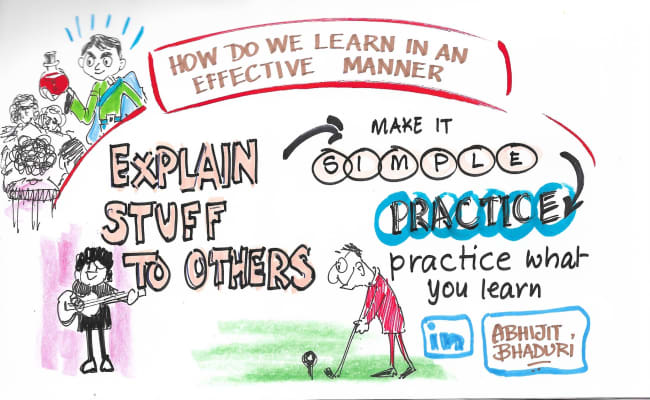Here's how you can make agile learning methods effective

"I am 29 years old. I spent three years in my father’s insurance firm. It has fifteen employees and it has grown steadily over the years. I spent three years being in the back office doing odd jobs. But today my father decided to put me in Sales, something that he has personally loved doing since the ‘80s. I remember he would often step out of a long drawn negotiation with a client and then tell me how much he enjoyed the negotiation. But I don’t think I could be like him and do the same job for three decades like he has. He has been giving me management books to read in order to get me to learn the new skill, but I don’t think I can learn like that. I learn by observing and then trying it out. I am starting the new job next week, and I am looking forward to it but I do not feel prepared enough. I guess, one day, I will be taking over the firm and being in Sales is a good place to get prepared.”
The Agile Learning Method: 4Es
Although a scenario like above is not unheard of and most of us have become leaders by learning on the job or through the help of management books, today’s business operating ecosystem demands much more from leaders as traditional or conventional learning methodologies do not make the cut. Organizations need to adopt the 4Es of agile learning to develop leaders in a rapidly shifting environment.
Education: Structured learning of the basics helps in building skills at scale. Learning the alphabet helps us to form words. We combine words to craft sentences. Reading the theory helps the learner understand the design principles of the competency being developed. Being aware of the core body of knowledge prepares a someone to join a profession. When someone says, “I am a practical person. I do not read”, you know this person is proudly flaunting his ignorance. Reading is a sign of intellectual curiosity and openness to new ideas in agile leaders. Weak signals and early trends often show up in a new book or article. An early start of a year can help an agile leader capture critical mass in the market.
Exposure: To be able to connect the dots, it is important to have enough dots to choose from. That is just what internships are designed to do. For example, being the apprentice of a top-notch practitioner gives a young surgeon the exposure to multiple variations and scenarios where they learn from the master surgeon. The Tata Administrative Service was designed for build leaders who had broad exposure to the business across geographies, whereas short-term assignments across geographies and functions over a two-year period was the basic principle of the Global 100 program of Wipro. Apple brought a leader from Burberry when they were launching their own stores. Agile leaders are able to adapt and implement ideas from other contexts.
Experience: Education gives the leader knowledge, learning, and a head-start. A musician will be taught the theory of music and then given exposure to multiple interpretations and possibilities as they watch several maestros interpret the same piece of music in their own unique manner. The Indian army puts its officers through various assignments during their careers. Every two to three years, they have to uproot the family and move to a new location and assignment. This helps them put their education and exposure to use. This is also the phase when having a coach can step-jump the competency of the agile leader. When a leader takes on a new role in the organization, having a coach can enable them to become productive early. Firms often spend a lot more on hiring leaders but will forget to invest in a coach who can onboard the new hire. Transition coaching is one of the most effective methods of building agility in a new hire.
Expertise: I have often seen master craftsmen practice a single line of a composition hundreds of times till they get it right. “Don’t you get bored doing the same thing over and over again?”, I have asked a famous music director. “Until I can play the notes to perfection from muscle memory I am not playing the same piece. It may all sound the same to a novice but an expert will know each quiver and tremble.” The difference of one hundredth of a second can be the difference between an Olympic gold medalist and a silver medalist. While a lot of people claim to have a passion for what they do, until they get comfortable with deliberate practice, they only have a fleeting interest – not passion. When someone says that they are passionate about something, check to see their comfort with repetition. The best cricketers are often the ones who will wake up an hour earlier than their peers to retain their extra edge. The Grand Slam winners still have a coach who will polish their craft even if the improvement will not be visible to others.

How do we learn effectively?
Add new mental models and theories: Try to explain things to others by simplifying complexity. Find examples from other fields that can help someone else experience an “aha” moment. Create something to practice what you learn.
Build time chunks to think and reflect: Most leadership development programs are ineffective because organizations do not build time and space for reflection.
Without time to reflect, it is hard to learn from failure.
Warren Buffet blocks chunks of his time every day to read, think, and reflect. He uses this time to process information from the environment, simulate, and predict and then update his own predictions before taking action. Ask if you are creating new mental models.
Become a part of a learning community: Being a part of a community of practice helps us to learn more effectively. It helps you to know what good looks like. Having a mentor can be a very powerful way to accelerate your learning. Create a group of mentors who will challenge your thinking and question your choices. They will connect you to other people you can learn from. A novice can be a great source of learning too.
Agile organizations continuously stay in touch with the outside environment and change their internal processes and workings to stay in tune. Agile leadership development, if done in a structured way, can help scale up the rest of the organization. The organization moves at the pace of the weakest link. Agility comes from everyday actions – not one-off training programs.











